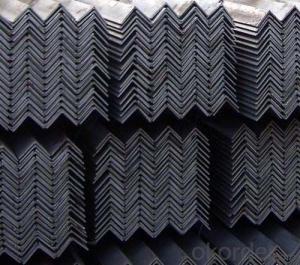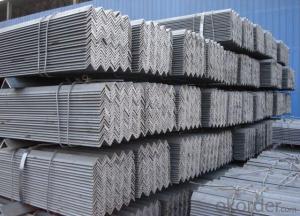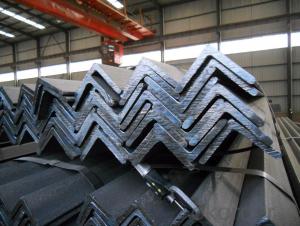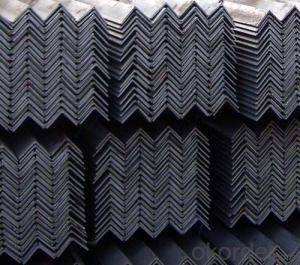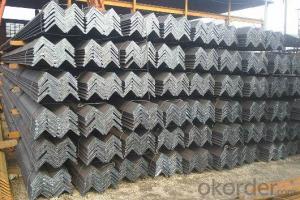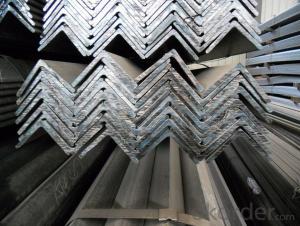Hot Rolled Steel Angle Bar with High Quality 25*25mm
- Loading Port:
- Tianjin
- Payment Terms:
- TT OR LC
- Min Order Qty:
- 25 m.t
- Supply Capability:
- 10000 m.t/month
OKorder Service Pledge
OKorder Financial Service
You Might Also Like
Product Description
Specifications of Equal Angle Steel
1.Standards:GB
2.Length:6m, 12m
3.Material:GBQ235 or Equivalent
4. Size:
Size (mm) | Mass (mm) | Size (mm) | Mass (mm) |
| 25*25*2.5 | 0.95 | 25*25*3 | 1.124 |
| 25*25*2.7 | 1.02 | 25*25*4 | 1.459 |
Usage & Applications of Equal Anlge Steel
Trusses;
Transmission towers;
Telecommunication towers;
Bracing for general structures;
Stiffeners in structural use.
Packaging & Delivery of Equal Angle Steel
1. Transportation: the goods are delivered by truck from mill to loading port, the maximum quantity can be loaded is around 40MTs by each truck. If the order quantity cannot reach the full truck loaded, the transportation cost per ton will be little higher than full load.
2. With bundles and load in 20 feet/40 feet container, or by bulk cargo, also we could do as customer's request.
3. Marks:
Color mark: There will be color marking on both end of the bundle for the cargo delivered by bulk vessel. That makes it easily to distinguish at the destination port.
Tag mark: There will be tag mark tied up on the bundles. The information usually including supplier logo and name, product name, made in China, shipping marks and other information request by the customer.
If loading by container the marking is not needed, but we will prepare it as customer request.
FAQ:
Q1: Why buy Materials & Equipment from OKorder.com?
A1: All products offered byOKorder.com are carefully selected from China's most reliable manufacturing enterprises. Through its ISO certifications, OKorder.com adheres to the highest standards and a commitment to supply chain safety and customer satisfaction.
Q2: How do we guarantee the quality of our products?
A2: We have established an advanced quality management system which conducts strict quality tests at every step, from raw materials to the final product. At the same time, we provide extensive follow-up service assurances as required.
Q3: How soon can we receive the product after purchase?
A3: Within three days of placing an order, we will arrange production. The shipping date is dependent upon the quatity, how many sizes you want and the plan of production, but is typically 30 to 45 days from the beginning of production.
Images:
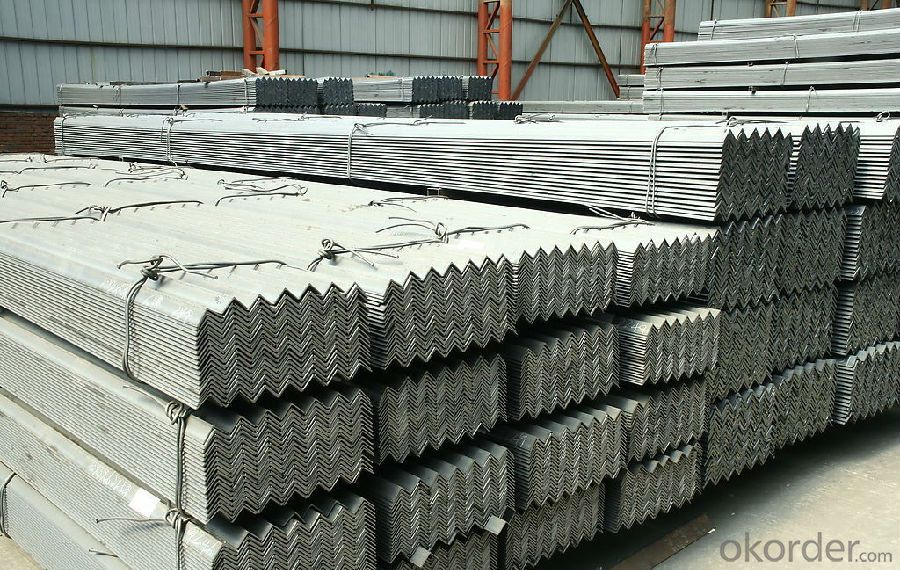
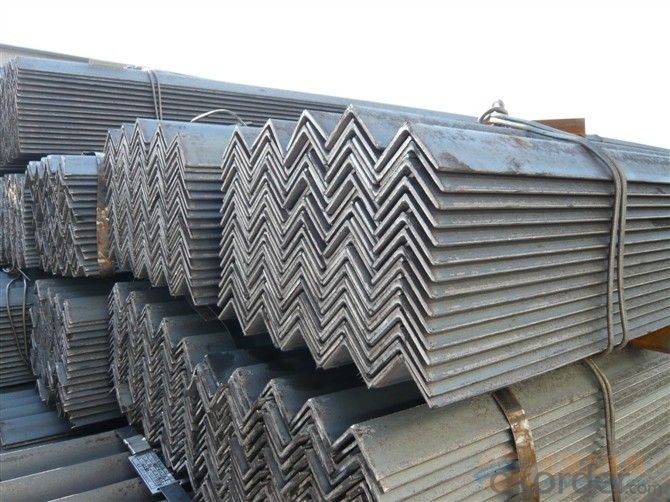
*If you would like to get our price, please inform us the size, standard/material and quantity. Thank you very much for your attention.
- Q: Can steel angles be used in the construction of industrial platforms?
- Certainly, the utilization of steel angles in the construction of industrial platforms is viable. Due to their exceptional strength and durability, steel angles are frequently employed in construction ventures. These angles can be easily joined via welding or bolting, thereby creating a robust and steady platform structure. Their utility is particularly evident in industrial arenas, where substantial loads and constant pedestrian traffic are to be anticipated. By providing support and stability, steel angles ensure that the platform can endure the weight and motion of machinery, equipment, and laborers. Furthermore, steel angles exhibit resistance to corrosion, rendering them suitable for deployment in diverse environments, including industrial settings that involve exposure to chemicals, moisture, and extreme temperatures. All in all, steel angles represent a dependable and cost-effective choice for the construction of industrial platforms.
- Q: How do you connect steel angles together?
- Steel angles can be connected together by various methods such as welding, bolting, or using steel angle brackets.
- Q: What are the different types of connections used for steel angles in industrial applications?
- In industrial applications, steel angles are commonly used for various structural purposes, and therefore, different types of connections are employed to ensure their stability and strength. Some of the different types of connections used for steel angles in industrial applications include: 1. Welded Connections: Welding is a widely used method to connect steel angles in industrial applications. It involves melting the edges of two steel angles together and allowing them to solidify, creating a permanent and strong connection. Welded connections provide excellent strength and durability, making them suitable for heavy-duty applications. 2. Bolted Connections: Bolted connections involve using bolts and nuts to secure steel angles together. Holes are typically drilled into the angles, and bolts are inserted through these holes and tightened using nuts. Bolted connections offer the advantage of being easily dismantled and modified, making them suitable for applications where frequent adjustments or repairs are necessary. 3. Riveted Connections: Riveting is a traditional method of connecting steel angles, although it is less commonly used in modern industrial applications. Riveted connections involve inserting a rivet through holes in the steel angles and then deforming the rivet to secure the angles together. Although riveted connections provide good strength, they are time-consuming and require specialized equipment. 4. Clip Connections: Clip connections involve using metal clips or brackets to connect steel angles. These clips are typically bolted or welded to the steel angles, providing a secure connection. Clip connections are often used in applications where quick and easy assembly and disassembly are required, such as temporary structures. 5. Gusset Plate Connections: Gusset plates are thin steel plates that are used to connect steel angles in industrial applications. These plates are typically bolted or welded to the steel angles, providing additional strength and stability. Gusset plate connections are commonly used in applications where higher loads or forces are expected. It is worth noting that the type of connection used for steel angles in industrial applications depends on various factors, including the load requirements, structural design, ease of assembly and disassembly, and the expected lifespan of the structure.
- Q: Can steel angles be painted or finished for decorative purposes?
- Yes, steel angles can be painted or finished for decorative purposes. Painting or finishing steel angles can enhance their appearance, provide protection against corrosion, and allow for customization to suit specific decorative needs.
- Q: Can steel angles be used as supports for overhead doors or garage doors?
- Indeed, overhead doors or garage doors can rely on steel angles as their supports. Due to their impressive strength and durability, steel angles are frequently employed in construction. They offer superb support and stability for hefty doors, making them an ideal selection for overhead or garage doors. By securely fastening the angles to the walls or framework, a sturdy foundation is provided for the doors to hang on and function seamlessly. Moreover, steel angles can be tailored to fit the precise dimensions and weight prerequisites of the doors, guaranteeing adequate support and functionality.
- Q: How do steel angles perform in terms of acoustic insulation?
- Steel angles, being primarily structural components, do not provide significant acoustic insulation. While steel itself is a dense material that can block some sound waves, the open design of steel angles, with their L-shape, results in poor sound absorption and transmission loss. Additionally, the thinness of steel angles and lack of any specific acoustic properties limit their effectiveness in reducing noise transfer. For optimal acoustic insulation, other materials such as acoustic panels, insulation batts, or soundproofing materials should be used in conjunction with steel angles to create a more effective sound barrier.
- Q: Are steel angles available in different finishes?
- Indeed, there are a variety of finishes available for steel angles. To enhance their appearance or provide extra protection against corrosion, steel angles can undergo different coatings or treatments. Some popular finishes for steel angles include galvanized, painted, or powder-coated options. Galvanized steel angles are coated with a layer of zinc to prevent rusting, while painted or powder-coated finishes offer a wide range of color choices for aesthetic purposes. Moreover, steel angles can also be left unfinished, creating a raw and industrial look. The diverse range of finishes for steel angles provides greater flexibility in their applications, allowing them to be customized to meet specific functional and aesthetic requirements.
- Q: Are steel angles resistant to corrosion?
- Yes, steel angles are generally resistant to corrosion. Steel angles are commonly made from carbon steel or stainless steel, both of which have inherent corrosion-resistant properties. Carbon steel angles have a protective layer of iron oxide, known as rust, which forms on their surface when exposed to oxygen and moisture. This rust layer acts as a barrier, preventing further corrosion of the underlying metal. Stainless steel angles, on the other hand, contain a minimum of 10.5% chromium, which forms a thin, transparent oxide layer on the surface. This oxide layer, called a passive film, provides excellent corrosion resistance, making stainless steel angles highly resistant to rust and other forms of corrosion. However, it is important to note that steel angles can still corrode under certain conditions, such as prolonged exposure to high levels of moisture or corrosive chemicals. Regular maintenance and proper cleaning can help extend the lifespan of steel angles and enhance their corrosion resistance.
- Q: Can steel angles be used for reinforcement in concrete structures?
- Yes, steel angles can be used for reinforcement in concrete structures. Steel angles, also known as L-shaped steel profiles, are commonly used as reinforcing bars in concrete construction. They provide increased strength and stability to the concrete structure, especially in areas where additional support is needed. Steel angles are typically placed within the concrete forms, ensuring proper alignment and spacing, and then embedded in the concrete during the pouring process. This reinforcement helps to prevent cracking and enhance the overall structural integrity of the concrete structure. Steel angles are versatile and can be used in various concrete applications, such as beams, columns, walls, and slabs.
- Q: Are steel angles suitable for high-temperature applications?
- No, steel angles are not suitable for high-temperature applications. Steel angles are typically made from carbon steel, which starts to lose its strength and structural integrity at elevated temperatures. At high temperatures, carbon steel undergoes a process called thermal expansion, where it expands and becomes weaker. This can lead to deformations and structural failures in the steel angles. For high-temperature applications, materials such as stainless steel or alloys with higher heat resistance, such as Inconel or Hastelloy, are more suitable. These materials can withstand higher temperatures without significant loss of strength and structural stability.
Send your message to us
Hot Rolled Steel Angle Bar with High Quality 25*25mm
- Loading Port:
- Tianjin
- Payment Terms:
- TT OR LC
- Min Order Qty:
- 25 m.t
- Supply Capability:
- 10000 m.t/month
OKorder Service Pledge
OKorder Financial Service
Similar products
Hot products
Hot Searches
Related keywords
